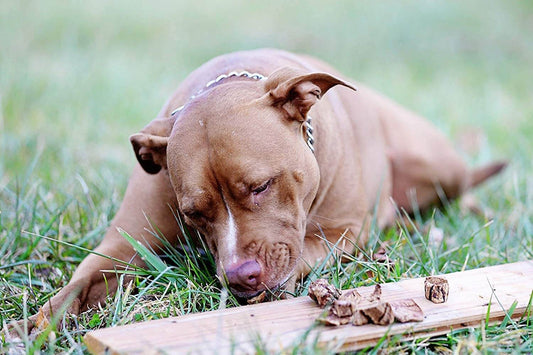
How to Spot Nutritional Deficiencies in Dogs: 8 Signs to Look For
Dawn Miller Feb 07, 20255 Minute ReadSometimes, the signs of nutritional deficiencies in dogs stare you in the face, but we don't notice them.
Last night, I was chatting with a college friend Lisa on social media. And she mentioned her 4-year-old Maltese, Teddy. He had been looking a little off lately—dull coat, low energy, and even some flaky skin. “Do you think it’s just winter blues—or could it be something serious? We have been cutting our walks short," she admitted. "It's just so cold here right now.”
Teddy's symptoms may not have been obvious to Lisa. But they certainly set off some alarm bells for me. This prompted me to ask some questions about what Teddy had been eating lately.
Signs of Nutritional Deficiencies in Dogs
Nutritional deficiencies can be tough to spot—even in humans—until they've gone too far and caused some more permanent issues. So, it's important to recognize the early signs of nutritional deficiencies in dogs and adjust dog nutrition to eliminate those signs.
Here's a look at some common red flags and what may be causing them:
1. Dull Coat and Hair Loss
A lack of essential omega 3 fatty acids or biotin (B7) can result in a dry, lifeless coat or even shedding beyond the usual seasonal patterns.
2. Low Energy Levels
If your dog seems sluggish, they might be missing essential vitamins like B12 or iron.
3. Digestive Issues & Immunity
Frequent diarrhea, constipation, or vomiting can indicate a lack of fiber, digestive enzymes, and collagen. Collagen makes up the intestinal lining, protecting the soft tissues.
Tummy troubles can also represent an overreactive immune system, which can be in part due to low omega 3 and conjugated linoleic acid (a type of omega 6 fat).
4. Bladder Inflammation
Trouble going, frequent urination, anxiousness around going, or going in inappropriate places can suggest a bladder issue.
Glucosamine and chondroitin are key components of the bladder lining, protecting it from infection and potential irritation from substances the kidneys and bladder are trying to eliminate.
5. Skin Problems
Flaky, itchy skin could indicate deficiencies in omega 6 fatty acids, omega 3, zinc, and antioxidants. Skin problems, especially allergies and dermatitis, are often due to an overactive immune system that sees harmless substances as potential invaders.
This leads to rashes, constant itching, and swelling in an incompetent attempt to get rid of the "innocent" allergen.
6. Slow Healing Wounds
A shortage of vitamin C or collagen (the structural protein) can slow the recovery process. Unlike humans, dogs can make vitamin C internally. But they can struggle to make enough.
7. Behavioral Changes
Nutritional gaps can sometimes cause anxiety, irritability, and even aggression, stemming from an imbalance of nutrients that support brain health. Omega 3, B12, and fiber are vital for mental health. They can reduce inflammation, improve mood, and feed the serotonin-producing microbes in the gut, respectively.
8. Mobility Issues
Is your pup walking tenderly, awkwardly, or slower than usual? Do they take their time to get up or down or constantly reposition themselves? These are signs of joint pain and instability.
The bones, joints, ligaments, tendons, and muscles support healthy joints. Key nutrients like the structural protein collagen, vitamin D, calcium, phosphorus, and zinc can each lead to mobility problems.
Joints are mostly made of collagen—along with the vital but often undervalued glucosamine and chondroitin. It's not normal for older dogs to experience mobility issues until very late in life.
Plus, mobility issues may reduce lifespan since they make it harder to stay active. So, this is something to address early. I start pups on joint supplements for dogs in middle age—and it would have been earlier if I'd had them as puppies.
Nutrition is complex. So, obviously, I didn't list every nutrient at play in these early signs of nutritional deficiency But you get the idea.
Serious Signs of Nutritional Deficiency in Dogs
When the deficiency is severe, it can result in bone pain, bone deformity, racing pulse, vision loss, memory loss, and dangerous levels of aggression. I told my friend Lisa that it's vital to stop the progression before it gets to this point.
What Causes Deficiency in Dog Nutrition
It's not just about what they eat I mean, that's a big part of it But there's more to it.
Dogs can become deficient because of:
- Imbalanced Diet. Not all commercial dog foods provide complete nutrition, especially if fillers outweigh quality ingredients. Some are clearly better than others. And I'd argue that any kibble will be lacking because it's cooked at high heat, destroying many nutrients like omega 3, vitamin C, and most antioxidants.
- Poor Absorption. Some dogs struggle to absorb nutrients properly due to digestive issues or conditions like inflammatory bowel disease (IBS). IBS is a vicious cycle because it's caused by nutritional deficiency, and the inflammation makes it worse.
- Overfeeding Processed Foods. Treats high in sugar, salt, or artificial ingredients can crowd out space for nutrient-dense options. You can get single ingredient dog treats, so there's no reason to give our babies these foods that are designed to be cheap and not nutritious.
Why My Dogs Deserve Single Ingredient Dog Treats
When Lisa asked me for tips, I told her what I give my dogs to ensure they get whole nutrition. Healthy treats for dogs include whole foods like roasted beef marrow-filled dog bones.
Marrow bones are loaded with some of the most common nutrients dogs lack, particularly:
- Omega 3 (Special note: Grass-fed beef has 2.5X the omega 3 of grain-fed cattle. And less saturated fat too!)
- Conjugated Linoleic Acid (an immune-balancing form of omega 6)
- Collagen (a lot of it!)
- B12, plus all the B vitamins
- Iron, Calcium, vitamin D, Zinc
- Glucosamine and Chondroitin
- Antioxidants, including vitamins A and E.
Plus, I like to refill each dog bone when the marrow is gone. This allows me to supplement their fiber and some antioxidants that bone marrow doesn't have, like the quercetin in pumpkin and apples mixed with Greek yogurt or peanut butter.
I also give them beef trachea chews for dog nutrition. These single ingredient dog treats are mostly collagen, glucosamine, and chondroitin with some vitamins and minerals. And I call them our dog toothbrushes because the ridges help dogs remove plaque as they instinctually chew.
Might as well improve dog health and dental health at the same time!
My final suggestion for Lisa was to evaluate your current dog training treats—by asking about the single ingredients. Do they have additives, preservatives, and fillers? Are they supporting dog nutrition or detracting from it?
I then recommended that she check out beef lung bites for training. These healthy treats for dogs are no-smell, all-flavor roasted organ meat—so you know it's "good stuff". Organ meat is rich in collagen, B vitamins, and healthy fats. Replace their ultra-processed training treats with single ingredient dog treats.
Using nutritious beef lung treats allows me to give them more training treats (within reason) without worrying about spoiling their dinner.
Since we're talking about training, I wanted to mention this Free 7-Day Dog Training Challenge. After all, nutrition works best when combined with exercise. In this series, you'll learn all the basics, plus fun interactive games you can play with your dog to promote dog health.
Available On:





